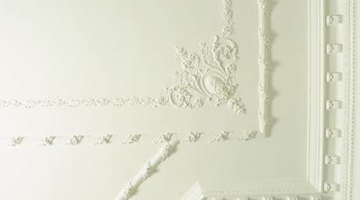Types of Plaster Ceilings
Plaster ceilings vary in materials, applications and even benefits. Plaster is a mixture of dry material and water that forms a paste. The paste is applied by hand with a trowel or sprayed onto the surface with a gun. Most historic buildings have plaster ceilings created from lime and gypsum. Homes built in the 1950s typically have popcorn acoustical ceilings created to hide drywall flaws and provide sound-dampening. Today's homes have a combination of popcorn, knockdown and other textured ceilings.
Lime and Gypsum Plaster

Older homes often feature lime or gypsum plaster ceilings. Lime was primarily used until the beginning of the 20th century when gypsum was introduced. Both materials were hand-applied to ceilings until gypsum was formed into drywall sheets in the 1950s. The plaster was mixed with sand, animal hair and occasionally hay for added grit and durability. Plaster's substructure has wood lath underneath, which gives the plaster something to grip onto. The application of hand-applied plaster wall greatly decreased with the ease and efficiency of installing gypsum prefabricated sheet rock.
Orange Peel
Orange peel texture is a very light, sprayed-on plaster that covers drywall flaws in the ceiling. The texture is created from joint compound mixed with water, and the effect mimics the actual orange fruit's outer surface. Orange peel texture only creates a small amount of plaster relief and may not always hide all drywall imperfections.
Popcorn Ceilings
Popcorn ceilings are a form of spray-on plaster mixed with plastic, foam or other material. The texture is considered an acoustical spray-on material that creates additional sound-proofing in a room. Once applied, it forms mounds or peaks on the ceiling. These are left in place and not smoothed down. The ceiling plaster is left unfinished, or a coat of paint may be applied. When the material was first introduced in the 1950s up through the 1980s, it contained asbestos. Today, the material no longer contains this hazardous material. However, older homes may still have asbestos ceilings, which must be removed by professionals for remodeling.
Skip Trowel
Skip trowel textures are exactly that: created by a drywall trowel that moves and jumps across the surface. Small amounts of joint compound are stamped onto the surface with a trowel. Stamping on the wet plaster creates peaks in the compound. These peaks are then knocked down to form large islands of texture. Skip troweling is also called knockdown, Spanish lace and executive. The material also provides sound-deadening and hides imperfect drywall installation.
References
- "Black and Decker Home Improvement 101: Everyday Care and Repair Made Easy"; Jerri Farris; 2005
Writer Bio
Julie Hampton has worked as a professional freelance writer since 1999 for various newspapers and websites including "The Florida Sun" and "Pensacola News Journal." She served in the U.S. Army as a combat medic and nurse for over six years and recently worked as the Community Relations Director for a health center. Hampton studied journalism and communications at the University of West Florida.
Photo Credits
- Hemera Technologies/AbleStock.com/Getty Images
More Articles



